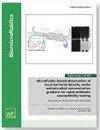利用微气泡流防止微流体系统堵塞和聚集的方法
IF 2.4
4区 工程技术
Q2 BIOCHEMICAL RESEARCH METHODS
引用次数: 0
摘要
本文提出了一种创新策略,以解决微流控设备中微通道的堵塞问题和与团聚相关的难题。利用三维(3D)微气泡流作为动态解决方案,我们的方法涉及在通道收缩附近受控激活微气泡,从而诱发具有独特特征的微流。这种微流的特点是具有高度非均匀的三维梯度和显著的剪切应力,可有效抑制收缩处拱形的形成并分解颗粒团,从而实时防止堵塞事件和堵塞。本研究包括防堵塞技术的实验验证、微流现象的详细研究及其对堵塞和团聚问题的影响。研究还纳入了在各种情况下进行的统计分析,以验证该方法的有效性和适应性。此外,还设计了一个多功能控制系统,可在事件触发、连续或周期模式下运行,适合不同的片上实验室应用,并提高了微流控系统的整体功能。本文章由计算机程序翻译,如有差异,请以英文原文为准。
A method to prevent clogging and clustering in microfluidic systems using microbubble streaming
This paper presents an innovative strategy to address the issues of clogging and cluster-related challenges in microchannels within microfluidic devices. Leveraging three-dimensional (3D) microbubble streaming as a dynamic solution, our approach involves the controlled activation of microbubbles near channel constrictions, inducing microstreaming with distinctive features. This microstreaming, characterized by a high non-uniform 3D gradient and significant shear stress, effectively inhibits arch formation at constrictions and disintegrates particle clusters, demonstrating real-time prevention of clogging incidents and blockages. This study includes experimental validation of the anti-clogging technique, a detailed examination of microstreaming phenomena, and their effects on clogging and clustering issues. It also incorporates statistical analyses performed in various scenarios to verify the method’s effectiveness and adaptability. Moreover, a versatile control system has been designed that operates in event-triggered, continuous, or periodic modes, which suits different lab-on-a-chip applications and improves the overall functionality of microfluidic systems.
求助全文
通过发布文献求助,成功后即可免费获取论文全文。
去求助
来源期刊

Biomicrofluidics
生物-纳米科技
CiteScore
5.80
自引率
3.10%
发文量
68
审稿时长
1.3 months
期刊介绍:
Biomicrofluidics (BMF) is an online-only journal published by AIP Publishing to rapidly disseminate research in fundamental physicochemical mechanisms associated with microfluidic and nanofluidic phenomena. BMF also publishes research in unique microfluidic and nanofluidic techniques for diagnostic, medical, biological, pharmaceutical, environmental, and chemical applications.
BMF offers quick publication, multimedia capability, and worldwide circulation among academic, national, and industrial laboratories. With a primary focus on high-quality original research articles, BMF also organizes special sections that help explain and define specific challenges unique to the interdisciplinary field of biomicrofluidics.
Microfluidic and nanofluidic actuation (electrokinetics, acoustofluidics, optofluidics, capillary)
Liquid Biopsy (microRNA profiling, circulating tumor cell isolation, exosome isolation, circulating tumor DNA quantification)
Cell sorting, manipulation, and transfection (di/electrophoresis, magnetic beads, optical traps, electroporation)
Molecular Separation and Concentration (isotachophoresis, concentration polarization, di/electrophoresis, magnetic beads, nanoparticles)
Cell culture and analysis(single cell assays, stimuli response, stem cell transfection)
Genomic and proteomic analysis (rapid gene sequencing, DNA/protein/carbohydrate arrays)
Biosensors (immuno-assay, nucleic acid fluorescent assay, colorimetric assay, enzyme amplification, plasmonic and Raman nano-reporter, molecular beacon, FRET, aptamer, nanopore, optical fibers)
Biophysical transport and characterization (DNA, single protein, ion channel and membrane dynamics, cell motility and communication mechanisms, electrophysiology, patch clamping). Etc...
 求助内容:
求助内容: 应助结果提醒方式:
应助结果提醒方式:


